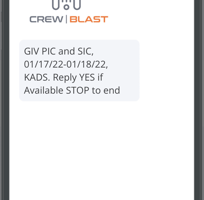CrewBlast is in need of a GIV PIC and SIC for a trip commencing on January 17, 2022 thru January...
Common Hurdles in Contract Flying | Pilot
Discover the top five common issues frequently encountered between operators and contract pilots below. This compilation provides a condensed overview of the challenges detailed in the preceding blog.
- Distinctions Between Commercial Pilot and ATP Certificates: The distinction between possessing a Commercial Pilot Certificate and an ATP is a prevalent challenge, particularly on smaller airframes, and surprisingly, it persists among some larger airframe candidates. Interestingly, fewer than 20% of operators with over 200 registered operators mandate an ATP Certificate for candidates, even in the role of SIC. We advocate for contractors to pursue an ATP certificate if they meet FAA requirements, which can be easily accomplished at their next flight training event.
- Similarly, some candidates hold a FAR 61.55 SIC Type rating: While this offers a relatively straightforward addition to the certificate, operators, and more importantly, insurance underwriters, do not find it highly desirable. Despite the cost difference between obtaining a PIC type and an SIC type rating, less than 5% of operators prefer contractors with an SIC type. Insurance providers identify that obtaining an SIC type rating is a relatively uncomplicated process, leading them to view it as a concern regarding the contractor's potential experience. This raises a red flag in evaluating the proficiency and background of a contractor with an SIC type rating.
- Maintaining PIC Currency on Multiple Type Ratings: The FAA permits a 12-month rotation for simulator-based recurrent training. This means that staying current on multiple type ratings, such as the BBD-700 and the GV, can be achieved by alternating recurrent sessions. This approach not only keeps you legal but also enhances your desirability for contract flying opportunities. With that said, we do have a small handful of operators who require 12month currency on each type rating held.
- Considerations for Accepting a PIC Contract: For those looking to accept a PIC contract, it's crucial not to overlook landing currency for both day and night operations. Many contractors, who often act as SIC, face challenges in meeting the three take-offs and landings at night required to maintain their 90-day currency. To address this, check with your flight training provider and your contract, as you may be able to fulfill this requirement without additional charges.
- Medical Certificate Transition: While receiving a class one medical is a positive step, it's important to note that depending on your age, this class can transition to a class two medical as early as six months. Despite regulations permitting commercial flying on a class two certificate, many operators still insist on a current class one medical. Contract pilots should stay mindful of this transition and take necessary steps to ensure ongoing compliance.
For more information, or questions pertaining to this post, please visit www.crewblast.co



